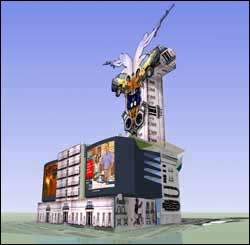 |
The fine art of punishment™ • The Barnes Collection and the Youth Study Center |
| Introduction Site Map Visual Guides Visit the Art Jail Home |
About the ArtJail Project.
As the endless Saga of the Barnes Foundation[1] rambles on many people are pondering the implications of moving the Barnes from the leafy, wealthy suburbs to the space on Philadelphia's Parkway that is currently occupied by the Youth Study Center[2]. Philadelphia City Paper columnist Bruce Schimmel did some of that pondering and, in January of 2005, wrote a column[3] suggesting that, instead of moving the Youth Sudy Center to West Philadelphia, the legacy Of Albert C. Barnes' educational philosophy would be best served by keeping the Center on the Parkway and combining it with the Barnes.
Damn; why didn't I think of that?
Anyway, it got my mind going and helped to gel whatever vague thoughts I'd had about the subject up to that moment. The image that flashed through my head immediately was of a combined lobby space for the two institutions and of some of the exhibitions that might be mounted there to comment on the social forces and relationships that produce both kinds of institutions. More ideas began to build in my mind and, as with my DisneyHole Project[4] of 2002, a simple idea became the springboard for a large project.
Dr. Albert Barnes’ envisioned his Foundation as an educational institution which was intended, in part at least, to enrich the lives of the poor and of African-Americans. However racist some of his writings may sound to us today[5], and whatever questions one might have about his educational philosophy it does seem that he was sincere in his desire to help to improve the lives of people in those groups. Is this desire (and the stated mission of the Foundation) best served by the removal from the Parkway of Youth Study Center, one of the last institutions in that area intended to serve those segments of the population? What role will the Barnes Foundation play in the accelerating displacement of low-income people from central Philadelphia? What role can art play in the education of troubled youth?
Any way you approach the many issues raised by the Barnes situation you're going to have to deal with the centrality of that most powerful of human delusions; race. Dr. Barnes, through his writings and by giving control over the selection of a majority of the Foundation's board of directors to Lincoln University, a historically black college, made race an explicit issue in a situation where it would otherwise have been considered to be a non-issue, but as the continuing battles over the relocation have raged on, racial issues have been shuffled offstage. The choice of the Youth Study Center site for the new Barnes should have brought race back into the conversation, since the inmate population there, as in most US prisons, is disproportionately African-American, but it hasn't, even with the proposed relocation of the YSC to a low-income, predominantly black neighborhood in West Philly. As is usual, anxious twittering about the sacred whims and wishes of the wealthy has taken center stage.
The story of the "revitalization" of Center City has been one of continual decline in the number of African-American residents, most conspicuously in the gentrification of Society Hill but also throughout the larger Center City area in a more gradual and less obvious fashion. One of the most eye-opening discoveries for me during the research for this project was a statistic buried in a publication[6] by the Center City District on the "expanding boundaries" of Center City (which now includes most of South Philadelphia, if you listen to some realtors). According to the US Census, between 1970 and 2000 the African-American population of what the CCD calls " the expanded area of Center City" declined by 43%. Lets repeat that, just for emphasis: between 1970 and 2000 the African-American population of what the CCD calls " the expanded area of Center City" declined by 43%. I haven't had time to track down the stats, but I suspect that if you went back to the 1950s and the beginnings of the "revitalization" of Society Hill the decline would be even more appalling.
While some of that decline is certainly due to "I don't want those people on my block"-style micro-racism my guess is that more of it is due to the larger, more insidious systemic, institutional, historical racism that has kept African-American (and especially urban African-American) average incomes the lowest of the four largest racial groups in the United States. As neighborhoods gentrify and low-income people are pushed out, the average skin-tone lightens significantly because the gentry tend to have lighter skin. Poor people of all skin-tones are pushed out, but, as in so many things, black people are disproportionately effected because of their status in this society.
So am I suggesting
(Sorry - I'm still working on this page.)
REFERENCES - MORE INFORMATION:
1). http://en.wikipedia.org/wiki/Barnes_Foundation_of_Philadelphia#History. - ^RETURN TO MAIN TEXT 2). Philadelphia City Paper article about the Youth Study Center. - ^RETURN TO MAIN TEXT 3). Philadelphia City Paper article about the Youth Study Center/Barnes situation by Bruce Schimmel. - ^RETURN TO MAIN TEXT 4). The DisneyHole Project. - ^RETURN TO MAIN TEXT 5). "Negro Art and America" The Survey Graphic Harlem Number (March 1925). - ^RETURN TO MAIN TEXT 6). "The Success of Downtown Living: Expanding the Boundaries of Center City" Central Philadelphia Development Corporation, April 2002. - ^RETURN TO MAIN TEXT 7). "http://en.wikipedia.org/wiki/Household_income_in_the_United_States#Race. - ^RETURN TO MAIN TEXT
 |
 |
The ArtJail Project was financed in part by a Pennsylvania Council on the Arts Fellowship and by a grant from the Puffin Foundation. |
